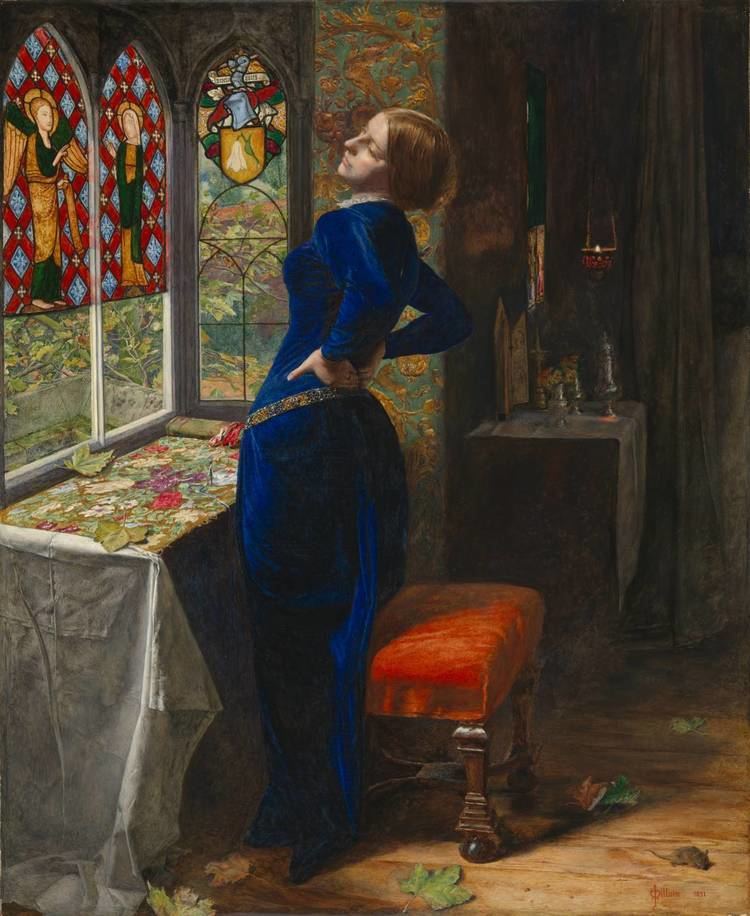Year 1851 Location Tate Dimensions 60 cm x 50 cm Period Romanticism Media Panel painting, Oil paint | Created 1850–1851 Genre Portrait | |
 | ||
Similar John Everett Millais artwork, Romantic artwork, Oil paintings | ||
Millais mariana
Mariana is an 1851 oil-on-wood painting by John Everett Millais. The image is based on the solitary Mariana from William Shakespeare’s Measure for Measure, written between 1601 and 1606. In the play, Mariana was to be married, but was rejected when her dowry was lost in a shipwreck. The painting is regarded as an example of Millais' "precision, attention to detail, and stellar ability as a colorist".
Contents
- Millais mariana
- John everett millais painting of mariana music by antony d i barnard
- History
- References
John everett millais painting of mariana music by antony d i barnard
History
When it was first exhibited at the Royal Academy in 1851, the display caption contained lines from Tennyson's "Mariana" (1830):
The Pre-Raphaelite Brotherhood wanted to create artworks that showed a sense of morality because they felt that the art world needed to go back to the old ways of painting. Raphael was one of the Renaissance painters that the Brotherhood admired, which is where the name of their group came from. The PRB wanted to create wondrous paintings that provided a moral lesson in the tradition of Raphael’s Renaissance paintings. However, that does not mean that the PRB only painted religious images. Oftentimes the PRB artists used allegorical images to create a narrative, which taught a moral virtue or virtues. Sometimes they even used contemporary literature as inspiration for their paintings. Many of their paintings include a large amount of details, which allow the viewer to “read” the painting. Since the PRB artists wanted viewers to read their paintings, they included so many details that the paintings became a narrative. Millais used Tennyson’s poetry to create a narrative for their paintings and he wanted to allow the viewer to read the entire poem through their painting. Although the artist can only show one scene from the poem, the Millais included details, which allude to the rest of the narrative that was not shown in the image. The viewers at the time would have been familiar with Tennyson’s poetry. Thus, they would be able to read the paintings very easily and associate Tennyson’s poetry with the narrative of the painting.
John Millais (1829–1896) was also a founding member of the PRB. He was born into a wealthy gentleman’s family and from a very young age his artistic talent was recognized. Millais was two years younger than Hunt but that did not dampen their friendship at all. At the age of 11, he was admitted into the Academy and exhibited several works there over a period of years. Millais married Effie Chalmers in 1855. Millais is known for Christ in the House of His Parents, and one of the paintings that Millais is most famous for is Bubbles (1886). This painting was actually sold to a soap company and used in their advertisements, but this was before copyright laws were around and so Millais did not receive royalties for his art being used in an advertisement. Later in his career, Millais made a name for himself as a painter of portrait.
Millais’ Mariana also used Tennyson’s poetry as a starting point for his painting. This painting is packed with details that help the viewer to read the narrative of the work along with Tennyson’s poetry. Everything from the rolled up embroidery that Mariana has been working on and the leaves outside of the window point the reader in the direction of the narrative which is about a young woman waiting for her husband to come back from a long journey. It is all about waiting and the passage of time, which Millais shows by the arched-back pose of the woman. The pose makes it seem like she has been sitting too long and she must stand up to stretch before she sits again. The rolled up embroidery on the table also gives the viewer a clue as to how long Mariana has been working on it while waiting for her lover to arrive.
In the painting Mariana, Millais included many details that relate directly to Tennyson’s poetry. One example is the curtain. In the poem, Tennyson wrote, “When thickest dark did trance the sky, She drew her casement-curtain by, and glanced athwart the glooming flats”. Although there is not a curtain in Millais’ painting, this line is similar to the scene that is presented outside of the window. The viewer perceives an ominous feeling, just like the dark storm that Tennyson alludes to in the line above. The little mouse that is on the floor towards the bottom right corner is a detail that Millais took from Tennyson’s poem: “the mouse behind the mouldering wainscots shriek’d or from the crevice peer’d about”. Together, Millais’ painting and Tennyson’s poem, create an intriguing storyline for the reader to follow.
